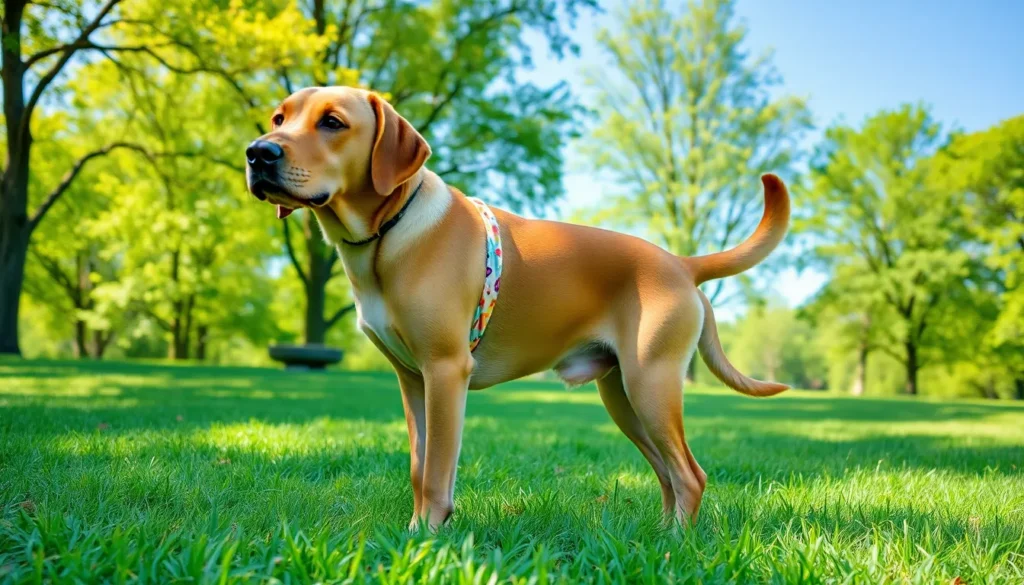Table of Contents
ToggleEvery dog owner knows that life with a furry friend is full of surprises. But when it comes to the monthly visitor that female dogs experience, things can get a bit confusing. Just like humans, dogs have their own version of a period, and understanding this natural cycle is essential for any responsible pet parent.
Understanding Dog Periods
Dog periods refer to the estrous cycle that female dogs undergo, similar to a human’s menstrual cycle. This cycle is vital for understanding a dog’s reproductive health.
What Are Dog Periods?
Dog periods are commonly called heats, marking a female dog’s fertile phase. These periods occur approximately every six months, but this frequency can vary based on the dog’s breed and age. During this time, a female dog exhibits signs of attraction, such as increased urination and behavioral changes. The heat lasts around three weeks, though it may range from two to four weeks, depending on individual factors.
The Estrous Cycle Explained
The estrous cycle consists of four distinct phases: proestrus, estrus, diestrus, and anestrus. Proestrus lasts about nine days and involves swelling of the vulva and bleeding. Estrus follows, lasting around nine days, during which the female is receptive to mating. Diestrus lasts about two months and occurs if pregnancy does not happen. Anestrus then represents a resting phase that can last several months. Understanding these phases aids in monitoring a dog’s reproductive health and behavior.
Factors Influencing Duration

Various factors influence the duration of a female dog’s heat cycle. Understanding these factors helps in managing reproductive health effectively.
Breed Variations
Different dog breeds experience varying lengths for their heat cycles. Larger breeds, like Great Danes, often have longer cycles, sometimes exceeding three weeks. In contrast, smaller breeds, such as Chihuahuas, may complete theirs within two weeks. It’s essential to research specific breed traits for precise expectations regarding heat duration.
Age and Health Considerations
A female dog’s age and overall health significantly impact her heat cycle duration. Younger dogs usually experience shorter cycles, while older dogs might have inconsistent lengths. Health issues, including hormonal imbalances or infections, can also lead to irregularities in the heat cycle. Regular veterinary check-ups ensure appropriate monitoring of these factors.
Typical Length of Dog Periods
The length of a dog’s heat cycle varies significantly. A typical cycle lasts around three weeks, though variations exist by breed and individual health.
Average Duration
Average duration for dog periods spans 18 to 21 days. The cycle consists of distinct phases: proestrus, estrus, diestrus, and anestrus. Proestrus lasts about 7 to 10 days, during which swelling of the vulva occurs, along with bleeding. Estrus follows, typically lasting 5 to 9 days, marking the female’s fertile window. After estrus, diestrus can last approximately 60 to 90 days, regardless of pregnancy. Anestrus extends from 4 to 5 months before the cycle restarts. Individual factors, such as breed size and age, can influence this duration.
Signs of a Dog in Heat
Signs of a dog in heat are noticeable. Increased urination often occurs, signaling behavioral changes and marking territory. A swollen vulva may indicate readiness for mating. Behavior might shift; increased affection or restlessness become common. Additionally, there could be more vocalizations and attention-seeking actions. These signs help owners identify when their dog is in heat, allowing for appropriate management. Recognizing these indications fosters responsible pet ownership.
Care During Dog Periods
Proper care during a dog’s heat cycle plays a crucial role in her health and well-being. Understanding what to expect and how to manage her needs ensures a comfortable experience.
Managing Hygiene
Hygiene management during a dog’s period is essential. Use doggy diapers to minimize messes in the home. Cleaning the area where the dog sleeps helps maintain cleanliness and comfort. Regular baths can assist in reducing odor and can keep her fur clean. Dispose of soiled materials promptly, preventing the buildup of bacteria. Consider using pet-safe cleaning products to ensure the environment remains safe and hygienic. Frequent checks on her diaper can help you identify any irritation or discomfort that may require attention.
Behavioral Changes to Expect
Behavioral changes during a dog’s heat cycle can be quite noticeable. Increased affectionate behavior may occur as instincts kick in. Many dogs display restlessness, making additional walks beneficial for releasing energy. Some females become more vocal or may exhibit clingy behavior towards their owners. Other dogs might show signs of nervousness, so creating a calm environment proves helpful. Understanding these changes can facilitate better communication and strengthen the bond between the dog and owner. Recognizing that these behaviors are temporary aids in managing them effectively.
Understanding a dog’s heat cycle is vital for responsible pet ownership. Recognizing the signs and phases helps owners provide appropriate care and support. Each dog is unique and factors like breed and age can influence the duration and characteristics of her cycle.
By staying informed and attentive to a dog’s needs during this time, owners can ensure their furry companions remain healthy and comfortable. Regular veterinary check-ups are essential for monitoring reproductive health and addressing any concerns that may arise. With proper care and understanding, managing a dog’s heat cycle can be a smoother experience for both the pet and the owner.



